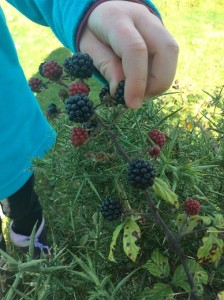
Blackberries must be one of our favourite and most commonly gathered wild food. Easy to recognise, children quickly learn how to identify blackberry fruits and eagerly help gather this annual feast. Foraging for wild foods is a wonderful activity which connects us to the seasons, increases observational and sensory skills and deepens our relationship to the natural world around us. For ‘blackberrying’ facts and activities read on ….
Brambles are a familiar untidy and prickly shrub, and a common sight growing along woodland edges, hedges and heathland. It is thought that there are 65 different species of bramble growing in the New Forest, with 400 micro-species in Britain. Keen blackberry pickers know how different each bramble patch can be. Some bushes have large sweet tasting fruit and on others they are small and bitter.
The clusters of blackberries also ripen at different times, lengthening this tasty wild harvest. The lowest berries, at the tip of each cluster, ripen first and taste the sweetest. It takes a few more weeks for the other berries ripen. Although less juicy these berries are great for making jams, jellies and pies.
There are of course hazards when excitedly picking blackberries – being prickled! Some of the best tasting blackberries grow amongst gorse bushes on the heathland, making picking doubly painful. Additionally, the growing bramble shoots which curve downwards to touch the ground and root (a clever mechanism to spread) make a mean trip hazard. But small scratches and cut clothing is all part of the foraging experience.
Many mammals, birds and insects also take advantage of this bounty. Listen for the buzz of insects feeding on the soft fruits and look for craneflies and shield bugs hiding amongst the foliage. I especially enjoy the spider webs hung amongst the bramble plants – glistening like jewels on dewy mornings. By late September the blackberrying season is usually almost over, as the fruits now begin to become mushy and flavourless, so its time to gather the last of the wild berry harvest.
Activity ideas:
Natural paints: Heat a cupful of blackberries in a small saucepan until soft and then push through a metal kitchen sieve or jelly bag to strain off the juice leaving the pips behind. The juice produces a beautiful pink to purple colour which also smells and tastes wonderful.
Taste Chart: Map out where the main blackberry patches are growing in your school grounds or local wild space. Design a chart which describes the size and colour of the blackberries and how the fruits taste – sweet, bitter, too many pips, watery etc. Each group investigating can choose their own descriptions. Then send out each group to taste and record findings. Can everyone agree which is the best tasting bramble patch?
Forager in training: Introduce and develop wild food observation skills by challenging the group to match collected fruits, seeds and leaves together. Poisonous species such as holly and yew berries can be compared to similar look alike species – Rowen and hawthorn. The Woodland Trusts ‘fantastic fruits’ spotter guide is a fun introduction for young children.
Spider spying: Bramble patches are a great place to study spider webs in early autumn. You can find orb and sheet webs and if you’re lucky see a web being spun. Use a fine mist of water sprayed onto the webs to make them stand out and easier to study.
Cooking with blackberries: There are lots of fun recipes where children can learn about setting points for making jams and jellies, making lolly pops and making toppings for a blackberry crumble. Enjoy!
